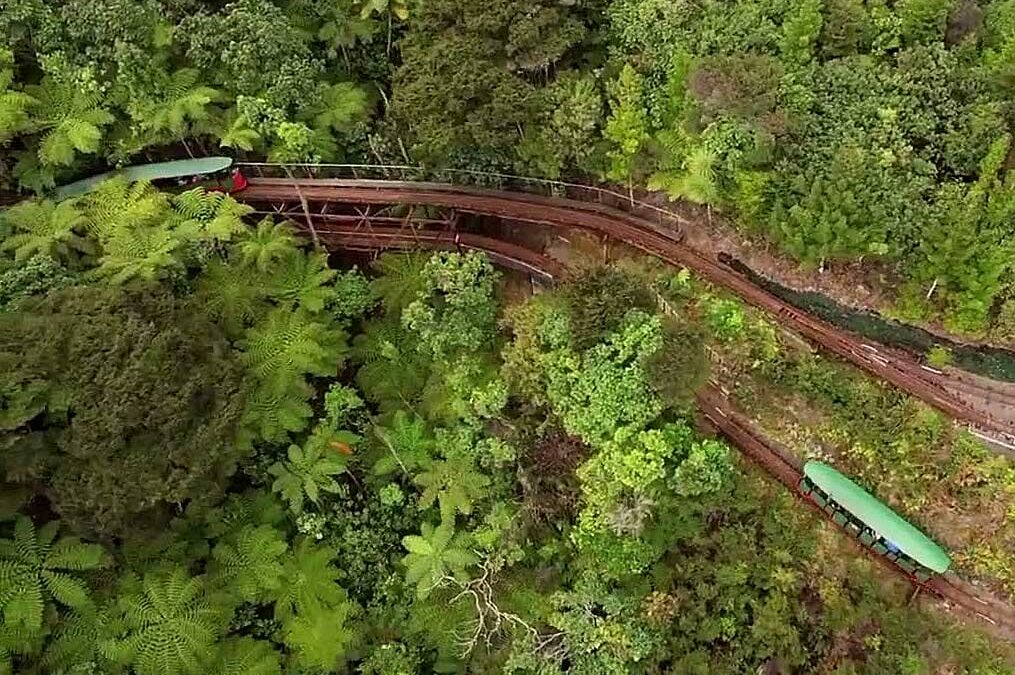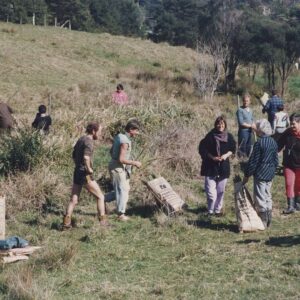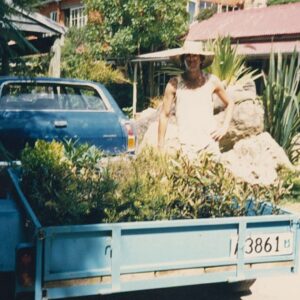“The whole district, including my block, had undergone 150 or so years of savage exploitation that was, in fact, ecological plunder.”
Barry Brickell
The Coromandel Peninsula, known for its stunning landscapes and rich biodiversity, is home to one of New Zealand’s most iconic trees: the Kauri. These magnificent giants showcase the region’s natural beauty and play a vital role in the cultural and ecological landscape. Driving Creek has played a part in replanting Kauri and other native trees through the hard work of Barry Brickell and his family and friends.
History of Kauri
Kauri trees (Agathis australis) are among the largest and longest-living trees in the world. Kauri can grow up to 16m in girth, 50 metres tall and can live for over 2,000 years. Tane Mahuta is the largest remaining Kauri tree and lives in the Waipoua forest measuring 45m tall. Kauri trees once covered 1,200,000 hectares of New Zealand. Now only 7,500 hectares of mature Kauri trees remain due to the logging industry. These ancient trees have thick, straight trunks and distinctive, spreading crowns. The wood of the kauri is renowned for its durability and resistance to decay, making it highly prized for construction and carving.
Logging of Kauri
Add dates – in the 18-1900’s? To harvest the wood, teams of bushmen would saw through the logs with a double-ended saw for upwards of 12 hours per log. Once the Kauri logs were felled in flatter regions they were towed out of the forest using a team of bullocks or horses. In the Coromandel region, the terrain is quite extreme so towing wouldn’t be a viable transport option. A method used to get the logs out of the forest was ‘driving’. Driving Creek is named after its past use in driving Kauri logs down to the harbour. Creeks were dammed up in the hills and filled with logs. Huge volumes of water were then released, washing the logs downstream to be milled or exported. Thousands of logs were sent down to booms below, though only 20% were estimated to arrive in a usable condition. In addition to the wood, the Kauri tree was also prized for its gum or sap. From the 1840s, kauri gum was exported to Britain and America to make varnishes. Between 1850 and 1950, 450,000 tons of gum were exported.
Cultural Significance of Kauri
Kauri trees hold deep cultural significance for Maori, the indigenous people of New Zealand. They are often associated with spirituality, and their timber has been used in traditional carving and construction. The Kauri gum was also used to make ink for Ta Moko, a traditional Maori tattoo. The gum was burnt and the ash was combined with animal fat to make ink. This ink was tattooed into the skin and as it hardened, caused a raised effect. Maori people would also use the Kauri sap for medicinal purposes and chew on it like gum combined with a plant called Puha to cure stomach aches and headaches. Kauri gum was also used for cooking and lighting because of its flammable properties.
Kauri Dieback Disease
Kauri forests are rich ecosystems that support diverse plant and animal life. The trees provide habitat for various species, including birds such as the TQTi and Kereru, as well as insects and other wildlife. The days of Kauri logging are now gone as the Department of Conservation has protected Kauri trees since 1987. Although logging is now banned, Kauri forests face significant threats from pathogens like Kauri dieback disease, which has led to widespread tree mortality. Kauri dieback disease poses a significant risk to our Kauri. It is a microscopic pathogen that is spread via infected soil. The pathogen that causes Kauri dieback disease, was first recorded on Great Barrier Island in the early 1970’s. There is no known cure for Kauri dieback so all Kauri trees which become infected will die. To help reduce its spread, visitors must carefully and respectfully follow the rules when visiting Kauri forests- not walking directly on Kauri roots or near Kauri trees, disinfecting their shoes and staying on formed tracks. Conservation efforts are crucial to protecting these ancient giants and the unique ecosystems they support.
Kauri at Driving Creek
Driving Creek is nestled in the heart of The Coromandel and is more than just a tourism operation. It’s a testament to the late Barry Brickell’s pioneering spirit and unwavering dedication to art, engineering, and conservation. Barry set out in the 1970s to return the Driving Creek land to pre-colonial times by replanting the 24-hectare property with over 27,000 native species including Rimu, Totara, Matai, Miro, Kowhai and Kauri.
“The whole district, including my block, had undergone 150 or so years of savage exploitation that was, in fact, ecological plunder. From virgin kauri forest to cut-over and logged forest, to repeated burn-offs, to freshly ‘broken-in’ farms, to abandoned, weed-infested, highly eroded hills, to 60 or so years of regenerating scrubland and fern. When I moved on to the land, the better parts were in tall Kanuka forest, which is really mature scrubland with the merest fraction of the diversity of plant and animal life of the original forest. Aware of this ecological history through study, my vision became fixed on reversing the decline of biodiversity.” – Barry Brickell.
Following Barry’s wishes after his passing in 2016, Driving Creek is now a not-for-profit organisation that delivers on its vision to protect and enhance the environment through pest animal and weed control and enrich the artistic community with our unique artist residency programme. We continue Barry’s conservation legacy of protecting and enhancing our native biodiversity by operating intensive pest animal and environmental weed control programmes, performing environmental research, running free conservation events, and connecting people with New Zealand’s natural qualities through enriching, educative and unique experiences.
Today, the property is covered in second-generation native forest and is QEII covenanted to protect the land for perpetuity. Driving Creek continues Barry’s vision and commitment to the Tiaki promise to protect, maintain and enhance our natural environment, be a community leader and centre for understanding and contribution to conservation initiatives, and continue improving the health and wellbeing of our local community and visitors. “To inspire others to heal and respect the land by showing what is being done and why. Appropriate utilisation rather than exploitation is demonstrated. Showing and telling is aimed at making the viewer and listener think and hopefully act.”- Barry Brickell.





